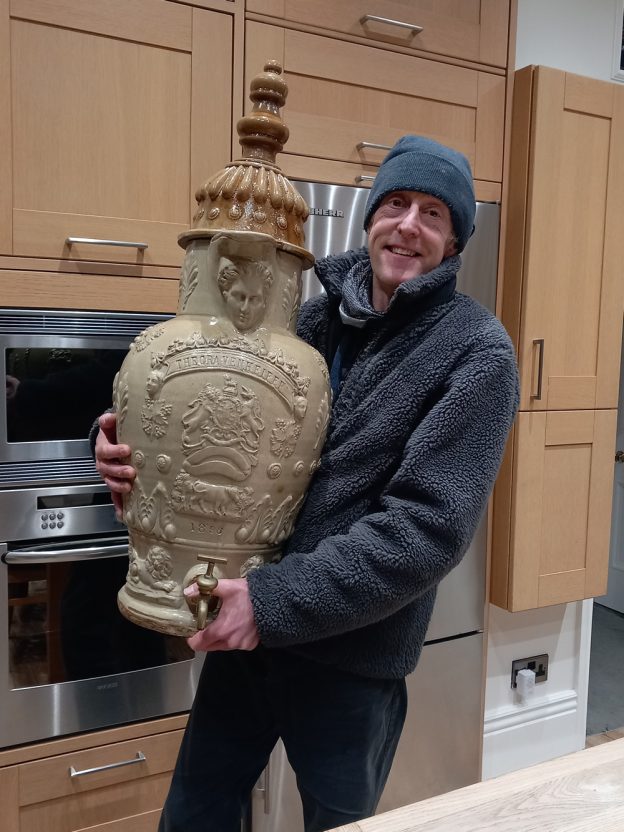This is a large stoneware jug, sprig decorated with a clear glaze over the main body and a celadon glaze on the lid. “The Craven Heifer” and the year 1896 are stamped onto it.
Because the jug has a pub name on it, it might be thought that this was made for serving alcohol, however I believe that this was a water jug and perhaps had a water filter in it.
This is an unusual pot and I have certainly seen no other like it attributed to a Burton pottery. I suspect it was commissioned by a public house named the Craven Heifer or even given to the publican as a gift? It has no markings as to where it was made, which is frustratingly typical of Burton pots. I feel certain though that it is Burton for three reasons:
1 – There are only a handful of pubs called the Craven Heifer in the country, most being in the North West and close to Burton, one in particular being in Ingleton, which is only 4 miles away from Burton. I feel there is a strong case for it being made for the Ingleton Craven Heifer, as the sign outside the pub includes the same year (1896) that is stamped onto the jug:
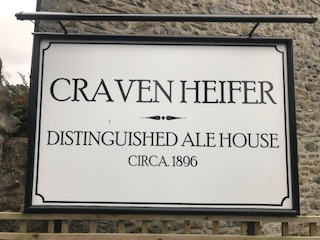
Could the jug have been made to commemorate the opening of the pub? Further research in “The History of Ingleton” by John Bentley suggests (with what looks like compelling evidence) that the Craven Heifer actually began around the 1840s, however it was bought around 1896 by Yates and Jacksons Brewery and they extended the pub at this time into the neighbouring cottages, so the jug could have been made to commemorate this? Betsy Ann Clapham was the landlady from around 1896 (John Bentley). Could Betsy Ann have ordered the jug?
2 – The unicorn and lion sprig decoration on the belly of the jug can be seen on another Burton pot (in the Folly in Settle).
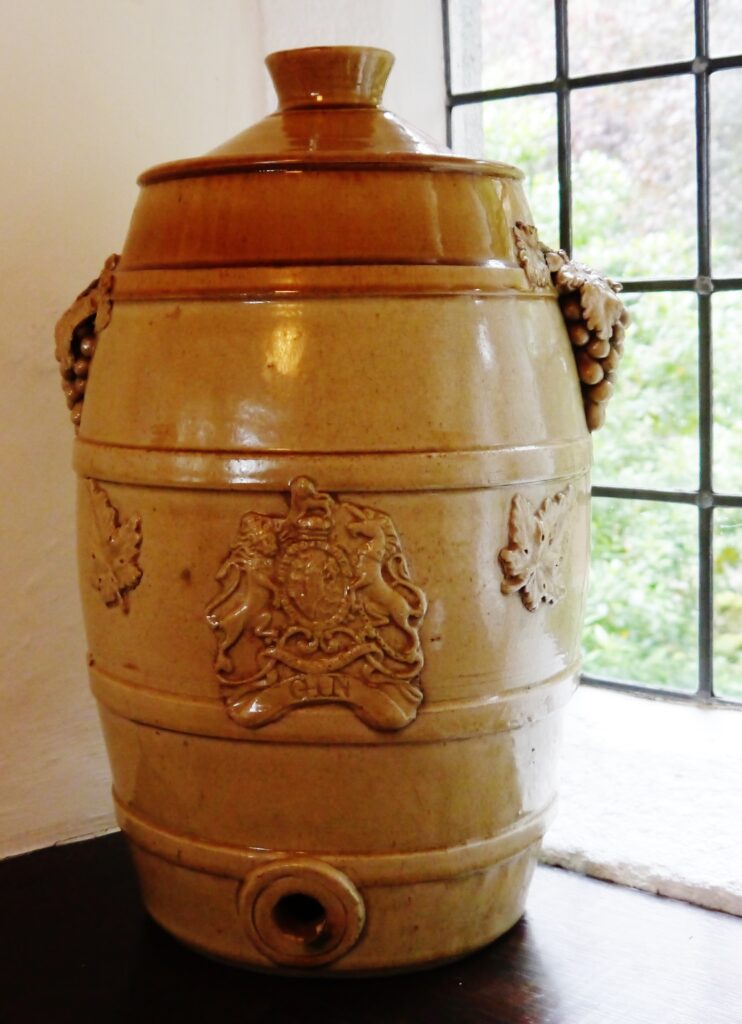
The unicorn and lion decoration looks identical on both pots and in all probability came out of the same sprig mould.
Interestingly the lion and unicorn sprig looks identical to the sprig on the following jug, produced by Manor Pottery, Eccleshill, Bradford:
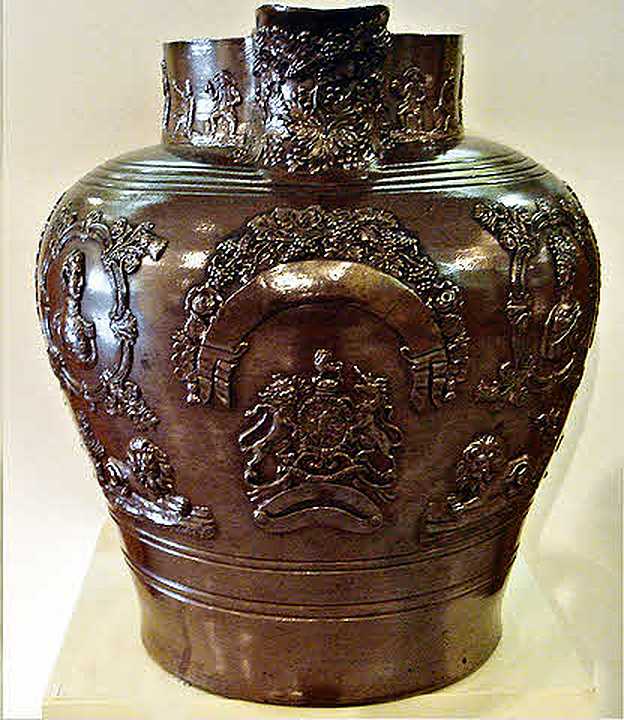
I believe that a Burton potter worked at Manor Pottery for a short while (possibly William Bateson around 1850, this is suggested in a Dalesman article published in 1949). I think it is very possible that the Burton potter in question may well have surreptitiously taken some impressions from some of Manor Pottery’s sprig moulds and then later cast them in plaster to effectively give them a working sprig mould and these moulds would have eventually ended up in Burton. The reason I don’t think the Craven Heifer jug was made at Manor Pottery is because it would have been salt glazed and also I doubt Manor Pottery would have used two different sizes of font for stamping “1896” – Manor Pottery was very much geared up to making sprig decorated stoneware – I suspect they wouldn’t have struggled to find the correct size font for any number.
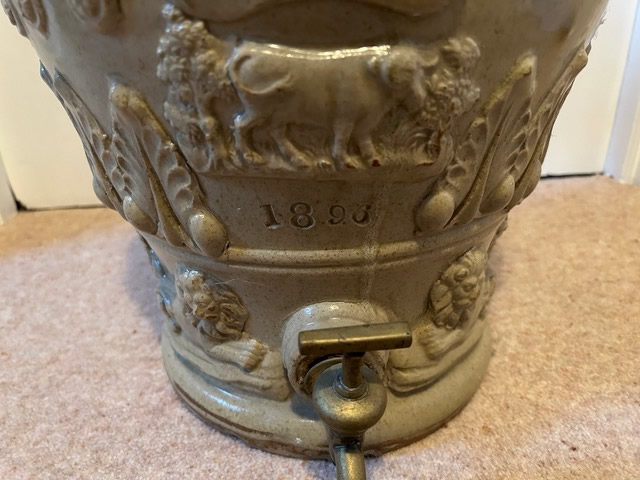
Another reason for it not being made at Manor Pottery, and I swear that I didn’t know this when I wrote the last paragraph, is that Manor Pottery actually closed in 1887 and the jug was made 11 years later! This leads me to a completely new theory, which is that one of the Burton potteries bought a job lot of press moulds from Manor Pottery when they closed down.
3 – There is a label on the back of the jug with the following “J. Seward Burton”. Seward is not a name that I normally associate with the Burton pottery industry, however after a little research, I was surprised. I found the following entry in the 1861 census:
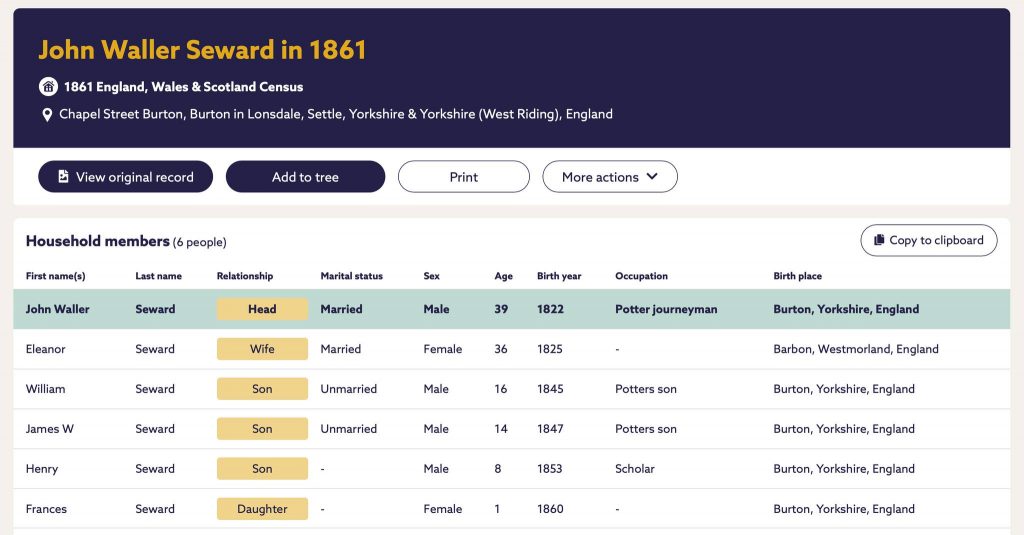
John Waller Seward is also in the 1881 census:

He was still making pots in the 1901 census, at the age of 78!
I have managed to build up a reasonably accurate account of John Seward’s life. I would like to take credit for what follows, but that would not be true. I put an earlier version of this article onto a Facebook group page and a chap called Ben from Belgium took an interest in the jug and very kindly did some research for me that allows me to say the following about John Waller Seward:
John Waller Seward was born in 1822. He was the illegitimate son of Martha Seward. Martha Seward died at the age of 19 shortly after the birth of John. Her death must surely have been related to the birth? Martha’s father, William Seward and mother, Anne Seward most likely brought up the young child. William Seward was a potter by trade and he briefly ran Lawsons Pottery (next to Potters Arms Pottery), before taking over the Walmsley Pottery (off High Street) around 1800 both of them located in Burton. It is likely that William taught John Seward pottery and/or arranged for him to work at another Burton pottery. John married Ellen Wilson in 1843 and by this time he had found out the name of his father, a John Tippin, who was a stone mason. As a young man I would guess that John worked at a number of potteries. I wonder if he worked for a time at Manor Pottery in Bradford? If this was the case then he may well have acquired the sprig moulds here that enabled him to make the Craven Heifer jug? I feel certain that John ended up working for Thomas Coates at the Baggaley Pottery and I suspect that it was here that the jug was made. The reason for me thinking that he worked at the Baggaley Pottery is that Thomas Coates’ name is on the probate form for John’s death at the ripe old age of 84 in 1906. John Seward exhibited his pottery locally and won prizes for his pots. In 1889, one of his vases sold for 15 shillings, which would be about £90 in today’s money.
What follows is the evidence that Ben from Belgium gave me that enabled me to write the last paragraph:


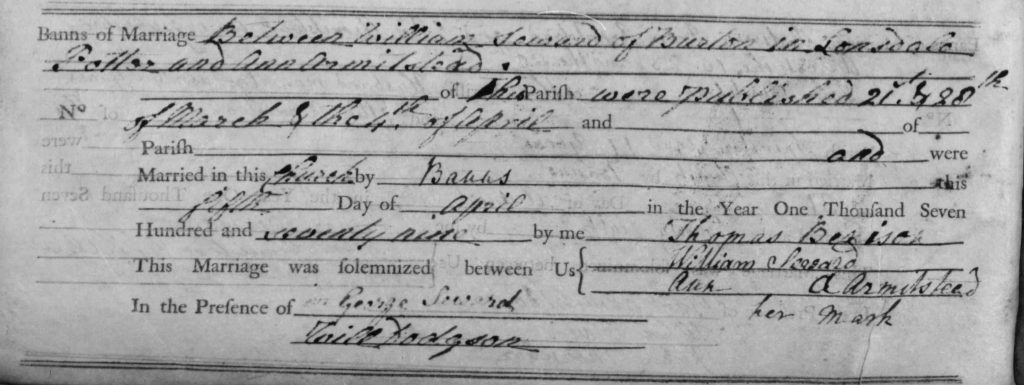





.
It’s a great pity that J Seward didn’t sign the base of the pot!
Up until this point I have to confess that I have only seen photos of the jug, however last night I visited the owner and got to see the jug. Members of the Burton in Lonsdale Heritage Group also joined me for this visit. I have to say that it is even more impressive in real life. One big surprise for me is the label with “J Seward Burton” is not a card label attached to the jug with a piece of string as I had imagined after talking with the owner, but a ceramic label stuck to the back of the jug. This proves conclusively that John Seward made the jug.
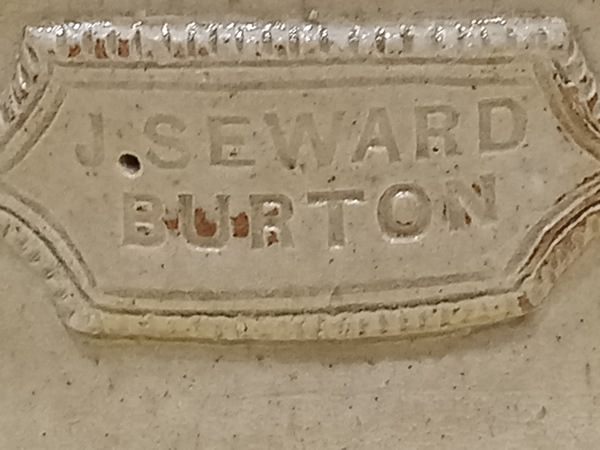
A number of people have commented that the lid was not made for the jug. Having handled the jug, I believe that it was. It fits the jug perfectly and the clay body (the unglazed bit) matches the clay body of the jug, also Jane Burns brought in an old photo of an exhibition of Burton pots from the 1970s and there is a very similarly decorated lidded vase which definitely has lid and body different colours. If I had made the jug, I would probably have taken some of the lid glaze onto the main body to create more of a unity between the lid and the jug.
People have also commented about it being salt glazed. This is definitely not the case. There is a thickness to the glaze and a definite separation between clay and glaze at the bottom of the pot that you just wouldn’t get with a salt glazed pot.
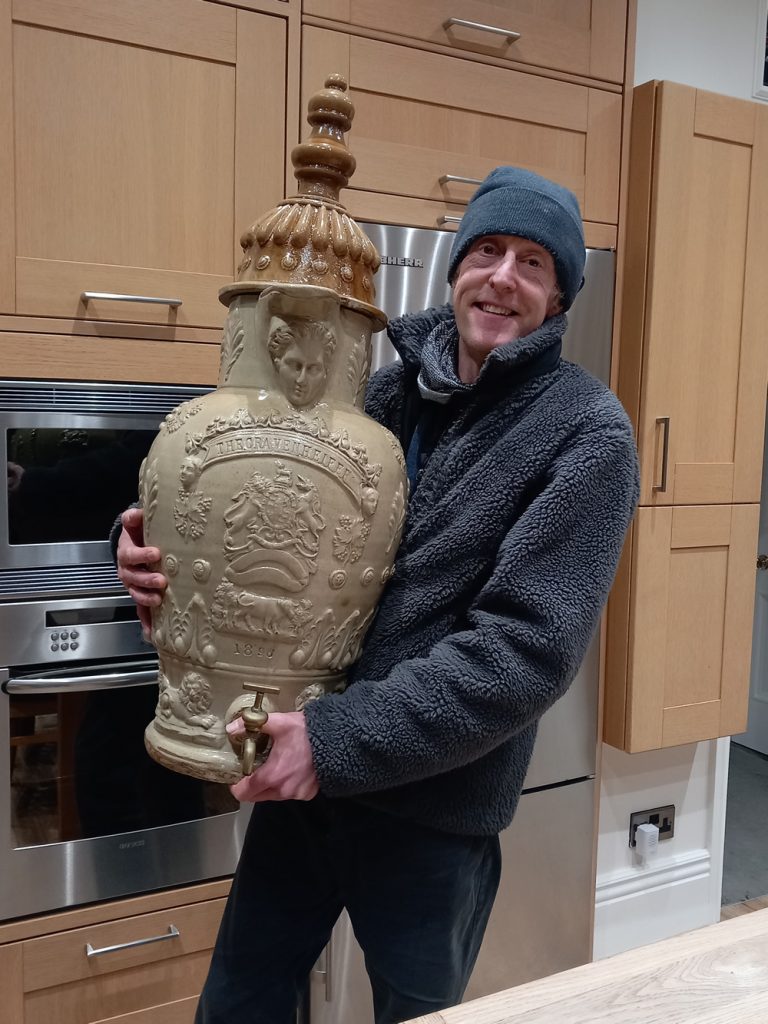
The next day, I was sent the following from Ben from Belgium, which proves conclusively that John Seward did indeed work for Thomas Coates at the Baggaley Pottery:

This was taken from the Lancaster Standard & County Advertiser, 29th June 1894 and it is talking about a ‘Grand Bazaar at Morecambe’, a grand multi-day event raising money for a church build fund. The event was attended by the Baggaley Pottery and their representative was John Seward, who they describe as a “fine art potter, who gives daily exhibitions of the manufacture of art pottery”.
I also received the following from Julie Gabriel-Clarke from the Burton in Lonsdale Heritage Group:
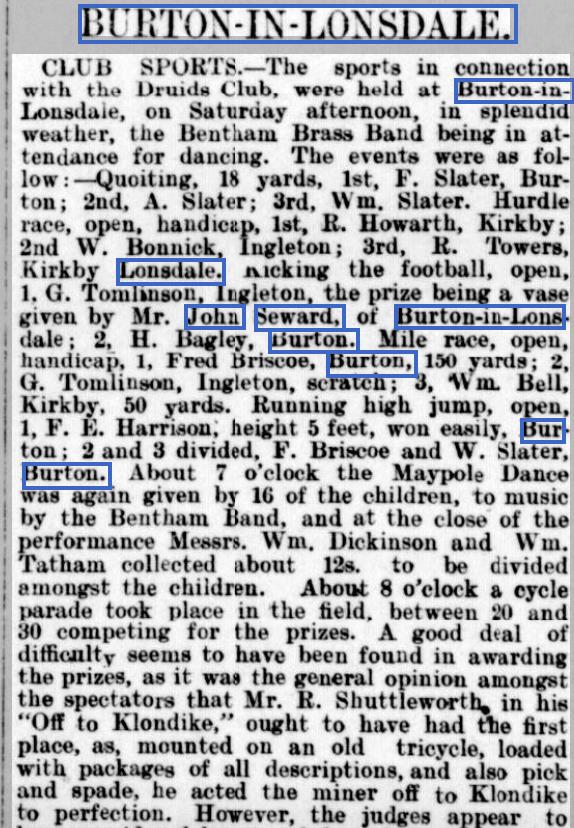
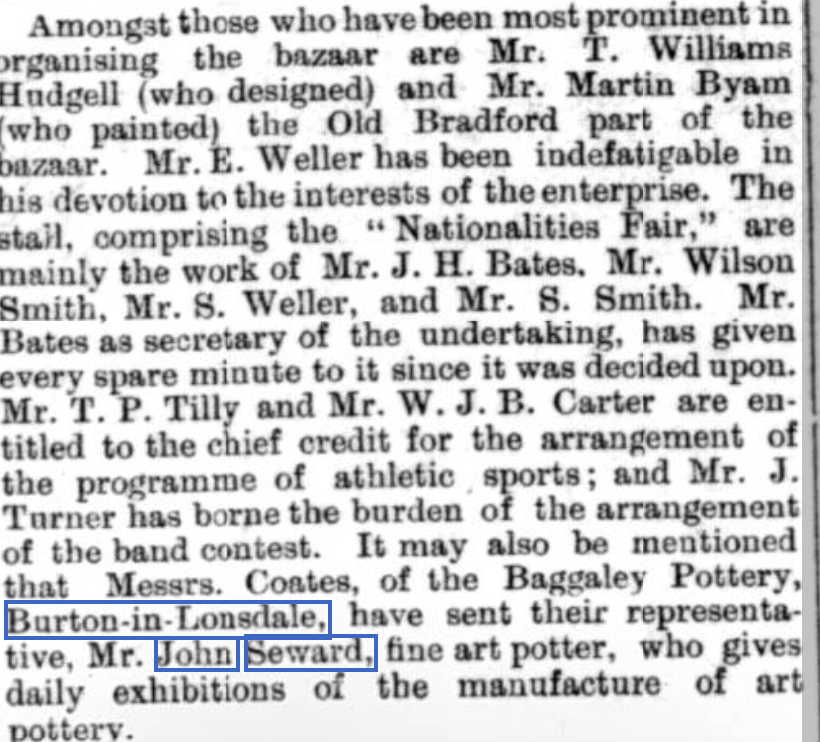


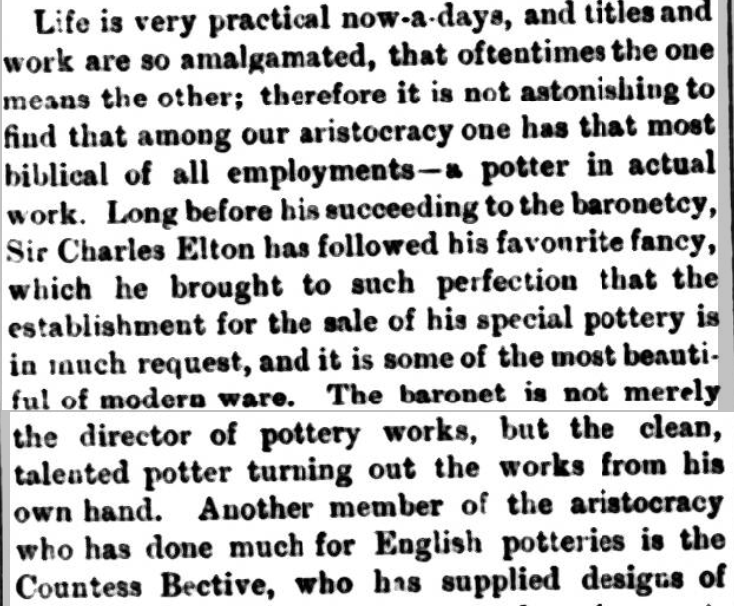
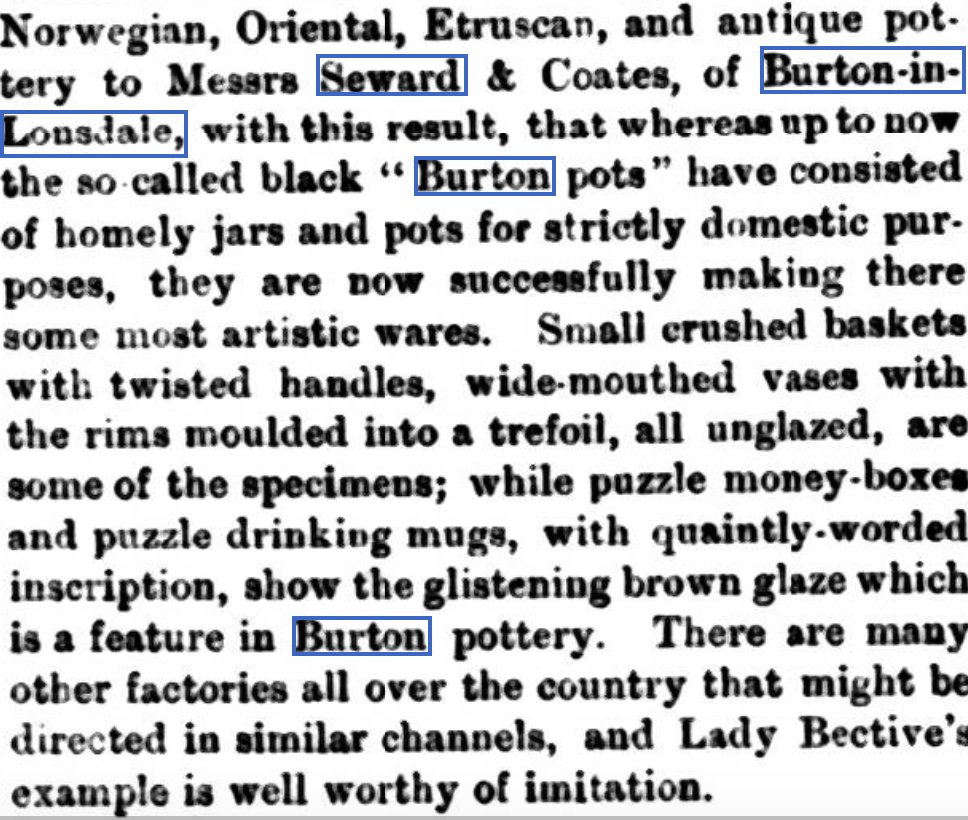
The previous newspaper clips make very interesting reading. It seems that John Seward perhaps encouraged by, or even in partnership with, Thomas Coates was delving into art pottery and was attending bazaars to sell and market their wares. Art pottery was a direct result of the Arts and Craft Movement where skilled factory workers would, perhaps with the help of a designer, produce individual one off pieces or small runs of items. A number of the Stoke potteries were experimenting producing art pottery around this time.
My guess is that John Seward was at an age where he could semi retire (this was before the state pension existed), but he didn’t want to give up pottery, however he wanted to make pottery to his own design/liking and not just endless repetition throwing. I guess this is something I aspire to myself, so I can definitely relate to this. Thomas probably encouraged him, possibly thinking that it was a direction that the industry at the time could take. Thomas was astute and a good business man and he may have thought that there could be some money in it. I also suspect that there was a lifelong friendship between the two men (Thomas Coates was one of the beneficiaries on John Seward’s probate form) so this would also have been an interesting venture for them both to share and enjoy.
The link with Lady Bective is an interesting one. Lady Bective lived at Underly Hall in Kirkby Lonsdale, so wasn’t too far away from Burton. It wasn’t uncommon for the aristocracy to dabble in the field of pottery, for instance The Manor House Pottery at Eccleshill, Bradford was established by Jeremiah Rawson, Lord of the Manor, about 1835 and more poignantly to the history of Burton-in-Lonsdale, Harold Parkinson of Hornby Castle invested a lot of money into Waterside Pottery in the late 1930s in an attempt to re boost the Burton-in-Lonsdale pottery industry. Could Countess Bective have had a part in designing the jug?
When John Seward made the jug he would have been 74 years old, which is an impressive age for what is undoubtedly an impressive pot!
This is a real show stopping big Burton pot. It would be great to see it on display in a museum. Lancaster Museum or The Folly at Settle would be ideal resting places for it. I just hope it doesn’t end up in shards in a house where its’ true value is not known. These pots are very rare.
Just when you think that this story can’t deliver anything else, it suddenly does. Lancaster Museum shared the story of the Craven Heifer jug on their Facebook page and it got the following comment;
“Hello Bentham Pottery, what an amazing piece of stoneware. I am intrigued. I haven’t come across the Burton group of potteries before, but I’m from Chesterfield in Derbyshire which had a well-established pottery industry from the 18th to the 20th century based to the West of the town (Brampton) and to the North (Whittington/Newbold). These were salt glaze stoneware potteries which after salt glazing became unacceptable shifted to making sprigged stoneware with a clear, lead free glaze. This offers parallels to this situation. The brown salt glazed stoneware jug you show here could easily be Brampton made. The sprigs are identical to ones I’ve seen on Chesterfield pots, the royal crest and the cow can be found on pots in Chesterfield Museum’s collection. I spent a long time tying myself in knots trying to use sprigs to attribute pots to individual potteries, and finding identical sprigs on pots from Bourne’s pottery (Denby near Derby) was deeply confused! The answer in part was that the sprig blocks from which the moulds were cast were bought in from Stoke on Trent from specialist block makers. Couple of other observations. Chesterfield Museum acquired a sizeable collection of sprig moulds which had been rescued from Barker Pottery the last Brampton pottery some of which came from other Brampton potteries that Barkers had taken over or that had found their way to Barkers when other potteries had closed down. It isn’t easy to be sure which pots were made at which pottery for another reason- they collaborated with each other, but fixing prices and sometimes subcontracting to another local pottery if they had an order they couldn’t handle themselves. There are many pieces that were specifically commissioned from the potteries by businesses and individuals. Even into the 1930s you could order a sprigged teapot with someone’s name on it as a special gift. Big pieces with the names of local pubs are known as are uncustomised spirit kegs. Really pleased to see this super example from your area!”
I submitted an article to the Craven Herald about the jug. Here is the article in full;
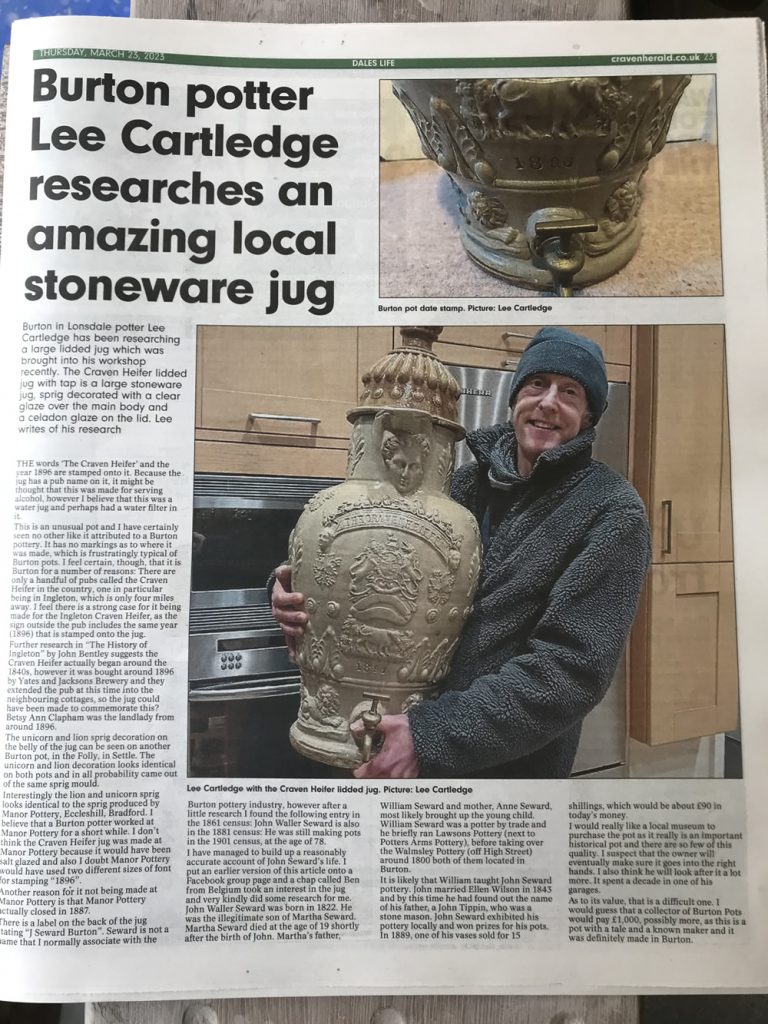
Shortly after the publication of this article an anonymous benefactor purchased the jug for the Folly Museum at Settle. This is a great outcome and I am pleased to say that the jug can now be viewed in the Folly.
Lee Cartledge (Bentham Pottery) 2023

